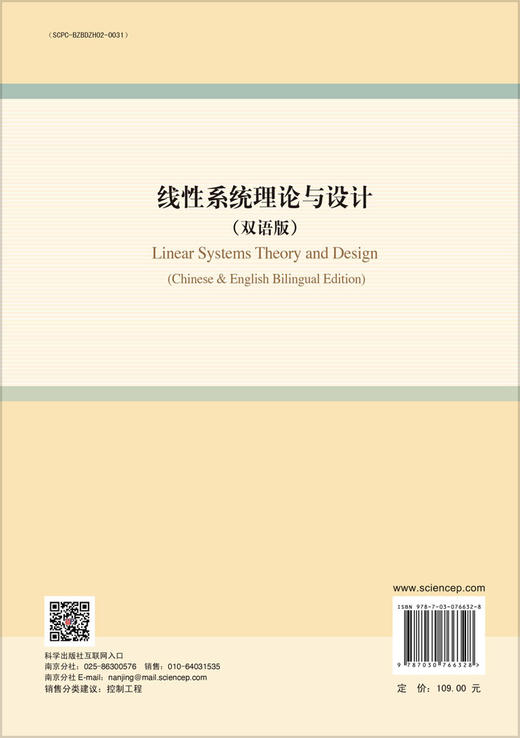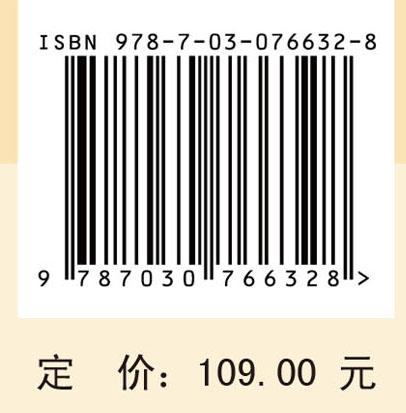商品详情
书名:线性系统理论与设计(双语版)
定价:109.0
ISBN:9787030766328
版次:1
出版时间:2024-05
内容提要:
本书内容涵盖控制相关学科各专业所必需的基础知识,以时域中的线性系统理论知识为主要内容,同时兼顾控制的频域知识。主要内容包括系统的数学描述、系统的动态响应、系统的能控性和能观性、系统的最小实现、系统的稳定性、系统的时域综合等。本书在内容论述上力求精练,在概念叙述上力求清晰,在理论分析上力求严谨,在系统设计方法和算法介绍上力求实用,在例证说明上力求简明。
目录:
目录
第1章 线性系统的数学描述 1
1.1 基本概念 1
1.1.1 因果性 2
1.1.2 线性 3
1.1.3 时不变性 3
1.2 系统的输入-输出描述 4
1.2.1 线性系统的脉冲响应 5
1.2.2 线性定常系统的传递函数矩阵 7
1.2.3 传递函数矩阵的 Smith-McMillan 形 8
1.2.4 传递函数矩阵的极点和零点 13
1.3 线性系统的状态空间描述 14
1.3.1 线性系统的动态方程 14
1.3.2 线性定常系统的特征结构 17
1.3.3 根据状态空间描述求传递函数矩阵 18
1.3.4 动态系统的等价 22
第2章 线性系统的动态响应 31
2.1 概述 31
2.2 线性时变系统的动态响应 32
2.2.1 线性时变系统的状态转移矩阵 33
2.2.2 线性时变系统的零输入响应 37
2.2.3 线性时变系统的零状态响应 38
2.2.4 线性时变系统的状态响应和输出响应 39
2.3 线性定常系统的动态响应 41
2.3.1 线性定常系统的矩阵指数.41
2.3.2 线性定常系统的零输入响应 48
2.3.3 线性定常系统的零状态响应 50
2.3.4 线性定常系统的状态响应和输出响应 51
第3章 线性系统的能控性和能观性 54
3.1 线性系统的能控性 54
3.1.1 基本概念 54
3.1.2 线性时变系统的能控性判据 56
3.1.3 线性定常系统的能控性判据 60
3.1.4 线性定常系统的能控性指数 66
3.2 线性系统的能观性 69
3.2.1 基本概念 69
3.2.2 线性时变系统的能观性判据 71
3.2.3 线性定常系统的能观性判据 73
3.2.4 线性定常系统的能观性指数 76
3.3 线性系统的对偶原理 78
3.3.1 对偶系统 78
3.3.2 对偶原理 79
3.4 线性定常系统的结构分解 80
3.4.1 线性系统在等价变换下的能控性和能观性 81
3.4.2 线性定常系统的能控性结构分解 81
3.4.3 线性定常系统的能观性结构分解 85
3.4.4 线性定常系统的 Kalman分解 86
3.4.5 极点、零点和特征值间的关系 89
第4章 线性定常系统的标准形和实现 94
4.1 线性定常系统的标准形 94
4.1.1 线性定常 SISO系统的标准形 94
4.1.2 线性定常 MIMO系统的标准形 99
4.2 能控性和能观性的频域形式 107
4.3 线性定常系统的实现 108
4.3.1 基本概念 108
4.3.2 线性定常SISO系统的实现 109
4.3.3 线性定常MIMO系统的实现 111
4.4 线性定常系统的最小实现 114
4.4.1 基本概念 114
4.4.2 线性定常SISO系统的最小实现 118
4.4.3 线性定常MIMO系统的最小实现 121
第5章 线性系统的稳定性 125
5.1 Lyapunov稳定理论 125
5.1.1 基本概念 125
5.1.2 Lyapunov第二法的主要定理 129
5.2 线性系统的内部稳定性.134
5.2.1 线性时变系统的内部稳定性.134
5.2.2 线性定常系统的内部稳定性.138
5.3 线性系统的外部稳定性.142
5.3.1 线性系统的 BIBO 稳定性 142
5.3.2 线性系统的 BIBS 稳定性 144
5.4 外部稳定和内部稳定的关系 145
第6章 线性系统的时域综合与反馈控制 148
6.1 状态反馈控制 148
6.1.1 状态反馈系统的能控性和能观性 148
6.1.2 SISO系统的状态反馈特征值配置 150
6.1.3 MIMO系统的状态反馈特征值配置 154
6.1.4 状态反馈镇定 162
6.2 输出反馈控制 166
6.2.1 输出反馈系统的能控性和能观性 166
6.2.2 输出反馈特征值配置 167
6.2.3 动态输出反馈补偿器 174
6.3 解耦控制 177
6.3.1 基本概念 177
6.3.2 状态反馈解耦 180
6.3.3 稳态解耦 186
6.4 状态观测器 188
6.4.1 全维状态观测器 188
6.4.2 降维状态观测器 191
6.4.3 函数状态观测器 195
6.4.4 带状态观测器的动态系统 198
参考文献 203
Contents
Chapter 1 Mathematical Description of Linear Systems 205
1.1 Basic Concepts 205
1.1.1 Causality 206
1.1.2 Linearity 207
1.1.3 Time-Invariance 208
1.2 Input-Output Description of Linear Systems 209
1.2.1 Impulse Response of Linear Systems 209
1.2.2 Transfer Function Matrix of Linear Time-Invariant Systems.212
1.2.3 Smith-McMillan Form of Transfer Function Matrices 213
1.2.4 Poles and Zeros of Transfer Function Matrices 218
1.3 State Space Description of Linear Systems 219
1.3.1 Dynamical Equations of Linear Systems 220
1.3.2 Characteristic Structures of Linear Time-Invariant Systems 223
1.3.3 Deriving Transfer Function Matrix from State Space Description 224
1.3.4 Equivalence of Dynamical Systems 228
Assignments 236
Chapter 2 Response of Linear Dynamical Systems 238
2.1 Introduction 238
2.2 Response of Linear Time-Varying Dynamical Systems 240
2.2.1 State Transition Matrix of Linear Time-Varying Systems 240
2.2.2 Zero-Input Response of Linear Time-Varying Systems 245
2.2.3 Zero-State Response of Linear Time-Varying Systems 246
2.2.4 State Response and Output Response of Linear Time-Varying Systems 247
2.3 Response of Linear Time-Invariant Dynamical Systems.249
2.3.1 Matrix Exponential of Linear Time-Invariant Systems.250
2.3.2 Zero-Input Response of Linear Time-Invariant Systems 257
2.3.3 Zero-State Response of Linear Time-Invariant Systems 259
2.3.4 State Response and Output Response of Linear Time-Invariant Systems 260
Assignments 261
Chapter 3 Controllability and Observability of Linear Systems 264
3.1 Controllability of Linear Systems 264
3.1.1 Basic Concepts.264
3.1.2 Controllability Criteria of Linear Time-Varying Systems 267
3.1.3 Controllability Criteria of Linear Time-Invariant Systems 270
3.1.4 Controllability Index of Linear Time-Invariant Systems.277
3.2 Observability of Linear Systems.279
3.2.1 Basic Concepts.279
3.2.2 Observability Criteria of Linear Time-Varying Systems 282
3.2.3 Observability Criteria of Linear Time-Invariant Systems 284
3.2.4 Observability Index of Linear Time-Invariant Systems 287
3.3 Duality Principle of Linear Systems 289
3.3.1 Dual Systems 290
3.3.2 Duality Principle 291
3.4 Structure Decomposition of Linear Time-Invariant Systems 292
3.4.1 Controllability and Observability of Linear Systems with Equivalent Transformation 292
3.4.2 Controllability Structure Decomposition of Linear Time-Invariant Systems.293
3.4.3 Observability Structure Decomposition of Linear Time-Invariant Systems 296
3.4.4 Kalman’s Decomposition of Linear Time-Invariant Systems 298
3.4.5 Relationships among Poles, Zeros and Eigenvalues 301
Assignments 305
Chapter 4 Canonical Form and Realization of Linear Time-Invariant Systems 308
4.1 Canonical Form of Linear Time-Invariant Systems 308
4.1.1 Canonical Form of Linear Time-Invariant SISO Systems 308
4.1.2 Canonical Form of Linear Time-Invariant MIMO Systems 313
4.2 Controllability and Observability in Frequency Domain 321
4.3 Realization of Linear Time-Invariant Systems 323
4.3.1 Basic Concepts 323
4.3.2 Realization of Linear Time-Invariant SISO Systems 324
4.3.3 Realization of Linear Time-Invariant MIMO Systems 326
4.4 Minimal Realization of Linear Time-Invariant Systems 329
4.4.1 Basic Concepts 329
4.4.2 Minimal Realization of Linear Time-Invariant SISO Systems 334
4.4.3 Minimal Realization of Linear Time-Invariant MIMO Systems 337
Assignments 340
Chapter 5 Stability of Linear Systems 342
5.1 Lyapunov Stability Theory 342
5.1.1 Basic Concepts.342
5.1.2 Main Theorems of Lyapunov’s Second Method 346
5.2 Internal Stability of Linear Systems 351
5.2.1 Internal Stability of Linear Time-Varying Systems 352
5.2.2 Internal Stability of Linear Time-Invariant Systems 356
5.3 External Stability of Linear Systems 360
5.3.1 BIBO Stability of Linear Systems 361
5.3.2 BIBS Stability of Linear Systems 363
5.4 Relationships between External Stability and Internal Stability 364
Assignments 366
Chapter 6 Synthesis and Feedback Control of Linear Systems in Time Domain 369
6.1 State Feedback Control 369
6.1.1 Controllability and Observability of System with State Feedback 369
6.1.2 Eigenvalue Assignment with State Feedback for SISO Systems 371
6.1.3 Eigenvalue Assignment with State Feedback for MIMO Systems 375
6.1.4 Stabilization with State Feedback 384
6.2 Output Feedback Control 388
6.2.1 Controllability and Observability of System with Output Feedback 388
6.2.2 Eigenvalue Assignment with Output Feedback 389
6.2.3 Dynamic Output Feedback Compensator 396
6.3 Decoupling Control 399
6.3.1 Basic Concepts.399
6.3.2 Decoupling with State Feedback 403
6.3.3 Steady State Decoupling 408
6.4 State Observer.410
6.4.1 Full-Order State Observer 410
6.4.2 Reduced-Order State Observer 414
6.4.3 Functional State Observer 418
6.4.4 Dynamical Systems with State Observer Feedback 421
Assignments 425
定价:109.0
ISBN:9787030766328
版次:1
出版时间:2024-05
内容提要:
本书内容涵盖控制相关学科各专业所必需的基础知识,以时域中的线性系统理论知识为主要内容,同时兼顾控制的频域知识。主要内容包括系统的数学描述、系统的动态响应、系统的能控性和能观性、系统的最小实现、系统的稳定性、系统的时域综合等。本书在内容论述上力求精练,在概念叙述上力求清晰,在理论分析上力求严谨,在系统设计方法和算法介绍上力求实用,在例证说明上力求简明。
目录:
目录
第1章 线性系统的数学描述 1
1.1 基本概念 1
1.1.1 因果性 2
1.1.2 线性 3
1.1.3 时不变性 3
1.2 系统的输入-输出描述 4
1.2.1 线性系统的脉冲响应 5
1.2.2 线性定常系统的传递函数矩阵 7
1.2.3 传递函数矩阵的 Smith-McMillan 形 8
1.2.4 传递函数矩阵的极点和零点 13
1.3 线性系统的状态空间描述 14
1.3.1 线性系统的动态方程 14
1.3.2 线性定常系统的特征结构 17
1.3.3 根据状态空间描述求传递函数矩阵 18
1.3.4 动态系统的等价 22
第2章 线性系统的动态响应 31
2.1 概述 31
2.2 线性时变系统的动态响应 32
2.2.1 线性时变系统的状态转移矩阵 33
2.2.2 线性时变系统的零输入响应 37
2.2.3 线性时变系统的零状态响应 38
2.2.4 线性时变系统的状态响应和输出响应 39
2.3 线性定常系统的动态响应 41
2.3.1 线性定常系统的矩阵指数.41
2.3.2 线性定常系统的零输入响应 48
2.3.3 线性定常系统的零状态响应 50
2.3.4 线性定常系统的状态响应和输出响应 51
第3章 线性系统的能控性和能观性 54
3.1 线性系统的能控性 54
3.1.1 基本概念 54
3.1.2 线性时变系统的能控性判据 56
3.1.3 线性定常系统的能控性判据 60
3.1.4 线性定常系统的能控性指数 66
3.2 线性系统的能观性 69
3.2.1 基本概念 69
3.2.2 线性时变系统的能观性判据 71
3.2.3 线性定常系统的能观性判据 73
3.2.4 线性定常系统的能观性指数 76
3.3 线性系统的对偶原理 78
3.3.1 对偶系统 78
3.3.2 对偶原理 79
3.4 线性定常系统的结构分解 80
3.4.1 线性系统在等价变换下的能控性和能观性 81
3.4.2 线性定常系统的能控性结构分解 81
3.4.3 线性定常系统的能观性结构分解 85
3.4.4 线性定常系统的 Kalman分解 86
3.4.5 极点、零点和特征值间的关系 89
第4章 线性定常系统的标准形和实现 94
4.1 线性定常系统的标准形 94
4.1.1 线性定常 SISO系统的标准形 94
4.1.2 线性定常 MIMO系统的标准形 99
4.2 能控性和能观性的频域形式 107
4.3 线性定常系统的实现 108
4.3.1 基本概念 108
4.3.2 线性定常SISO系统的实现 109
4.3.3 线性定常MIMO系统的实现 111
4.4 线性定常系统的最小实现 114
4.4.1 基本概念 114
4.4.2 线性定常SISO系统的最小实现 118
4.4.3 线性定常MIMO系统的最小实现 121
第5章 线性系统的稳定性 125
5.1 Lyapunov稳定理论 125
5.1.1 基本概念 125
5.1.2 Lyapunov第二法的主要定理 129
5.2 线性系统的内部稳定性.134
5.2.1 线性时变系统的内部稳定性.134
5.2.2 线性定常系统的内部稳定性.138
5.3 线性系统的外部稳定性.142
5.3.1 线性系统的 BIBO 稳定性 142
5.3.2 线性系统的 BIBS 稳定性 144
5.4 外部稳定和内部稳定的关系 145
第6章 线性系统的时域综合与反馈控制 148
6.1 状态反馈控制 148
6.1.1 状态反馈系统的能控性和能观性 148
6.1.2 SISO系统的状态反馈特征值配置 150
6.1.3 MIMO系统的状态反馈特征值配置 154
6.1.4 状态反馈镇定 162
6.2 输出反馈控制 166
6.2.1 输出反馈系统的能控性和能观性 166
6.2.2 输出反馈特征值配置 167
6.2.3 动态输出反馈补偿器 174
6.3 解耦控制 177
6.3.1 基本概念 177
6.3.2 状态反馈解耦 180
6.3.3 稳态解耦 186
6.4 状态观测器 188
6.4.1 全维状态观测器 188
6.4.2 降维状态观测器 191
6.4.3 函数状态观测器 195
6.4.4 带状态观测器的动态系统 198
参考文献 203
Contents
Chapter 1 Mathematical Description of Linear Systems 205
1.1 Basic Concepts 205
1.1.1 Causality 206
1.1.2 Linearity 207
1.1.3 Time-Invariance 208
1.2 Input-Output Description of Linear Systems 209
1.2.1 Impulse Response of Linear Systems 209
1.2.2 Transfer Function Matrix of Linear Time-Invariant Systems.212
1.2.3 Smith-McMillan Form of Transfer Function Matrices 213
1.2.4 Poles and Zeros of Transfer Function Matrices 218
1.3 State Space Description of Linear Systems 219
1.3.1 Dynamical Equations of Linear Systems 220
1.3.2 Characteristic Structures of Linear Time-Invariant Systems 223
1.3.3 Deriving Transfer Function Matrix from State Space Description 224
1.3.4 Equivalence of Dynamical Systems 228
Assignments 236
Chapter 2 Response of Linear Dynamical Systems 238
2.1 Introduction 238
2.2 Response of Linear Time-Varying Dynamical Systems 240
2.2.1 State Transition Matrix of Linear Time-Varying Systems 240
2.2.2 Zero-Input Response of Linear Time-Varying Systems 245
2.2.3 Zero-State Response of Linear Time-Varying Systems 246
2.2.4 State Response and Output Response of Linear Time-Varying Systems 247
2.3 Response of Linear Time-Invariant Dynamical Systems.249
2.3.1 Matrix Exponential of Linear Time-Invariant Systems.250
2.3.2 Zero-Input Response of Linear Time-Invariant Systems 257
2.3.3 Zero-State Response of Linear Time-Invariant Systems 259
2.3.4 State Response and Output Response of Linear Time-Invariant Systems 260
Assignments 261
Chapter 3 Controllability and Observability of Linear Systems 264
3.1 Controllability of Linear Systems 264
3.1.1 Basic Concepts.264
3.1.2 Controllability Criteria of Linear Time-Varying Systems 267
3.1.3 Controllability Criteria of Linear Time-Invariant Systems 270
3.1.4 Controllability Index of Linear Time-Invariant Systems.277
3.2 Observability of Linear Systems.279
3.2.1 Basic Concepts.279
3.2.2 Observability Criteria of Linear Time-Varying Systems 282
3.2.3 Observability Criteria of Linear Time-Invariant Systems 284
3.2.4 Observability Index of Linear Time-Invariant Systems 287
3.3 Duality Principle of Linear Systems 289
3.3.1 Dual Systems 290
3.3.2 Duality Principle 291
3.4 Structure Decomposition of Linear Time-Invariant Systems 292
3.4.1 Controllability and Observability of Linear Systems with Equivalent Transformation 292
3.4.2 Controllability Structure Decomposition of Linear Time-Invariant Systems.293
3.4.3 Observability Structure Decomposition of Linear Time-Invariant Systems 296
3.4.4 Kalman’s Decomposition of Linear Time-Invariant Systems 298
3.4.5 Relationships among Poles, Zeros and Eigenvalues 301
Assignments 305
Chapter 4 Canonical Form and Realization of Linear Time-Invariant Systems 308
4.1 Canonical Form of Linear Time-Invariant Systems 308
4.1.1 Canonical Form of Linear Time-Invariant SISO Systems 308
4.1.2 Canonical Form of Linear Time-Invariant MIMO Systems 313
4.2 Controllability and Observability in Frequency Domain 321
4.3 Realization of Linear Time-Invariant Systems 323
4.3.1 Basic Concepts 323
4.3.2 Realization of Linear Time-Invariant SISO Systems 324
4.3.3 Realization of Linear Time-Invariant MIMO Systems 326
4.4 Minimal Realization of Linear Time-Invariant Systems 329
4.4.1 Basic Concepts 329
4.4.2 Minimal Realization of Linear Time-Invariant SISO Systems 334
4.4.3 Minimal Realization of Linear Time-Invariant MIMO Systems 337
Assignments 340
Chapter 5 Stability of Linear Systems 342
5.1 Lyapunov Stability Theory 342
5.1.1 Basic Concepts.342
5.1.2 Main Theorems of Lyapunov’s Second Method 346
5.2 Internal Stability of Linear Systems 351
5.2.1 Internal Stability of Linear Time-Varying Systems 352
5.2.2 Internal Stability of Linear Time-Invariant Systems 356
5.3 External Stability of Linear Systems 360
5.3.1 BIBO Stability of Linear Systems 361
5.3.2 BIBS Stability of Linear Systems 363
5.4 Relationships between External Stability and Internal Stability 364
Assignments 366
Chapter 6 Synthesis and Feedback Control of Linear Systems in Time Domain 369
6.1 State Feedback Control 369
6.1.1 Controllability and Observability of System with State Feedback 369
6.1.2 Eigenvalue Assignment with State Feedback for SISO Systems 371
6.1.3 Eigenvalue Assignment with State Feedback for MIMO Systems 375
6.1.4 Stabilization with State Feedback 384
6.2 Output Feedback Control 388
6.2.1 Controllability and Observability of System with Output Feedback 388
6.2.2 Eigenvalue Assignment with Output Feedback 389
6.2.3 Dynamic Output Feedback Compensator 396
6.3 Decoupling Control 399
6.3.1 Basic Concepts.399
6.3.2 Decoupling with State Feedback 403
6.3.3 Steady State Decoupling 408
6.4 State Observer.410
6.4.1 Full-Order State Observer 410
6.4.2 Reduced-Order State Observer 414
6.4.3 Functional State Observer 418
6.4.4 Dynamical Systems with State Observer Feedback 421
Assignments 425
- 科学出版社旗舰店 (微信公众号认证)
- 科学出版社秉承多年来形成的“高层次、高水平、高质量”和“严肃、严密、严格”的优良传统与作风,始终坚持为科技创新服务、为传播与普及科学知识服务、为科学家和广大读者服务的宗旨。
- 扫描二维码,访问我们的微信店铺
- 随时随地的购物、客服咨询、查询订单和物流...




![[按需印刷]桥牌的数学定律/张跃辉](https://img01.yzcdn.cn/upload_files/2022/08/22/FvNg5xdU5H8rHOl2QwMl2oDAXQJ7.jpg?imageView2/2/w/260/h/260/q/75/format/jpg)


![[按需印刷]煤层瓦斯含量法预测煤与瓦斯突出理论与技术](https://img01.yzcdn.cn/upload_files/2020/03/18/FsjHBNSrxs1XH2KqcvU0im4Pbq2H.jpg?imageView2/2/w/260/h/260/q/75/format/jpg)




